Ghee roast dosa recipe with step by step photos. The world of dosas is also as varied and versatile as any other common dish from the cuisine of South India. One such awesome variation is that of this Ghee Roast Dosa. This is also the easiest way you can amp-up your regular plain dosas, by just cooking the dosa with the lovely ghee or clarified butter. This results in a restaurant-style crisp roasted dosa laced with the flavors of ghee.
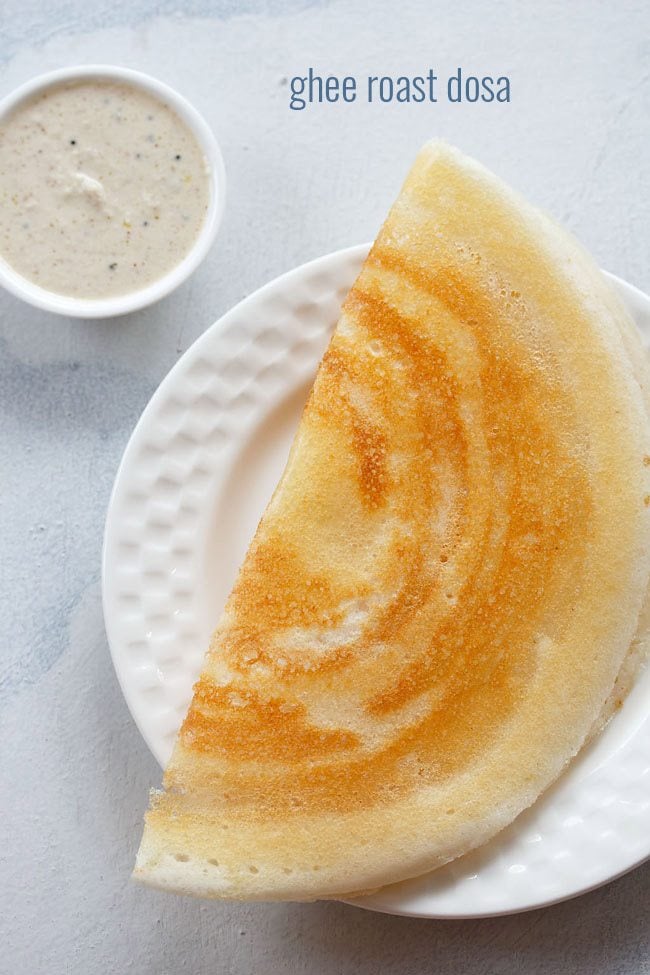
Ghee roast dosa is one of the popular dosa variety liked by many folks. Usually I just make simple plain or Sada dosa with some coconut chutney. But at times I make these crisp ghee dosa too.
I use my restaurant style masala dosa batter recipe to make ghee roast. Though you can even use regular Idli batter or dosa batter recipe to make ghee roast. In the post I have shared both the dosa batter and the preparing ghee roast on tawa. With this same dosa batter recipe, you can also make crisp dosas.
While making ghee roast dosa, one important tip is to maintain the temperature of the tawa. If the tawa is hot, you won’t be able to spread the batter. If the tawa is not hot, the dosa will not become crisp. So while cooking, you need to maintain a medium temperature in the tawa.
Also use a well seasoned tawa. By seasoned, I mean a tawa which is only used for making dosas. You can use a non stick pan or a cast iron tawa. I do have a cast iron tawa, but its a small one. Since I wanted to make large dosas, I have here used a large non stick pan to cook dosas.
Ghee roast dosas can be served folded or made into a cone dosa. If using a cast iron pan, then you can make the cone dosas, as you need to cut the dosa and then fold in a cone. If using a non stick pan, then avoid doing this.
Serve them hot with coconut chutney and sambar for a comforting meal.
How to make Ghee Roast Dosa
1. First take all the ingredients in three bowls:
- 1.5 cups idli rice or parboiled rice in one bowl
- ½ cup urad dal + 1 tablespoon chana dal + 20 methi seeds/fenugreek seeds in a second bowl
- ⅓ cup thick poha in a third bowl.

2. Rinse the lentils and methi seeds a couple of times in fresh water. Then soak them in 1 cup of water for 4 to 5 hours.

3. Rinse the rice a couple of times and keep it aside.

4. Rinse poha once or twice and then add to the rice.
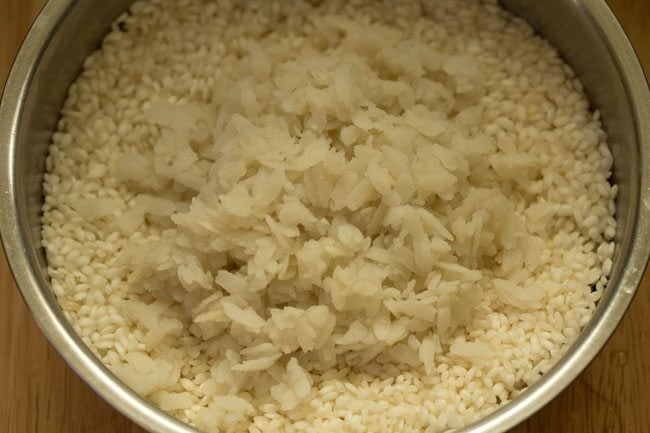
5. Pour 2 cups water. Stir and soak both rice and poha together for 4 to 5 hours.

6. Before grinding, strain the water from the soaked lentils+methi seeds and keep it for grinding urad dal.
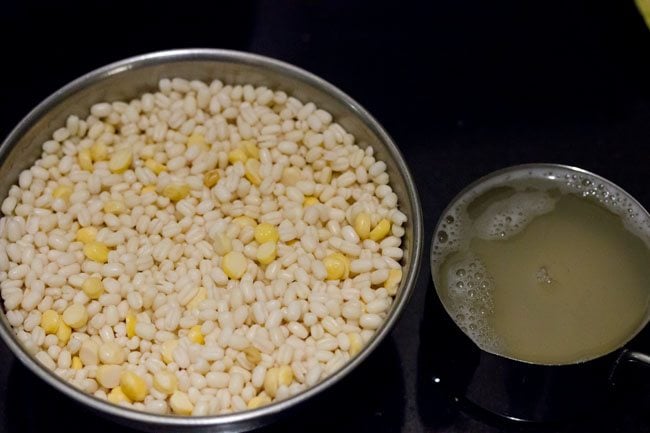
7. Add the lentils in the grinder jar. Also add ½ cup of the soaked and strained water to the dal.

8. Grind the urad dal, chana dal and methi seeds till you get a batter which is light and fluffy. The urad dal has to be ground really well, so that the batter ferments well.

9. Remove the batter in a bowl or pan with a spatula. Here is a pic showing the consistency of the batter.
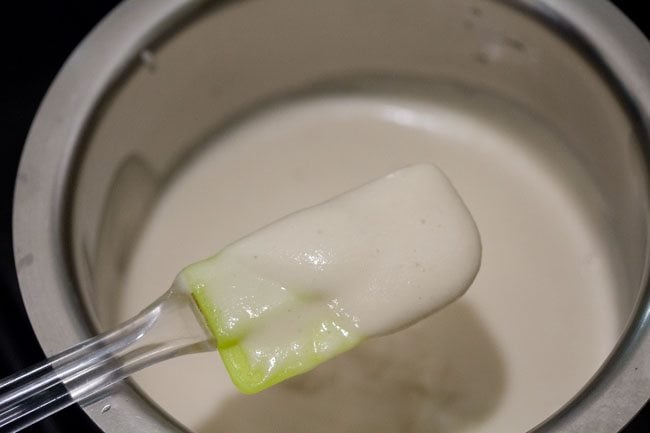
10. Strain the rice well. Then in the same grinder, add the soaked rice and 1 cup fresh water. You can grind rice in one batch or in two to three batches. This will depend on the size of the grinder jar.
I ground in one batch and added 1 cup water for grinding. You can even add ¾ cup water while grinding. Addition of water will depend on the quality of rice.

11. Grind the rice till you get a fine grainy consistency in it. The rice batter should have a fine rawa like consistency in the batter.
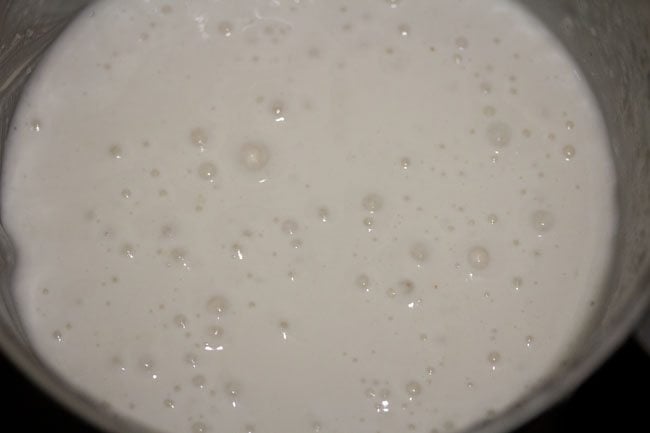
12. Now pour the rice+poha batter in the same pan or bowl containing the urad dal batter.
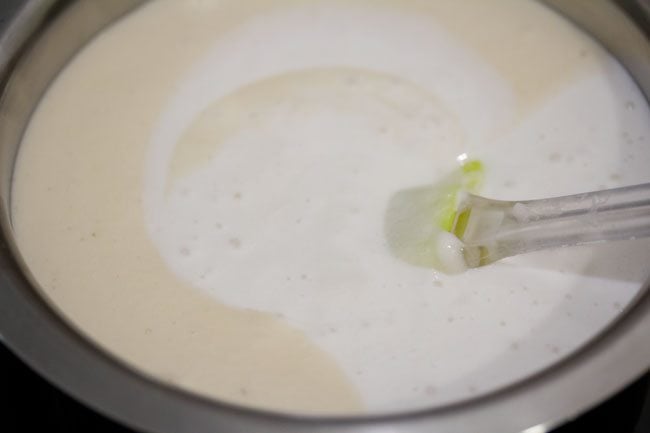
13. Add ½ teaspoon rock salt or add as per taste.
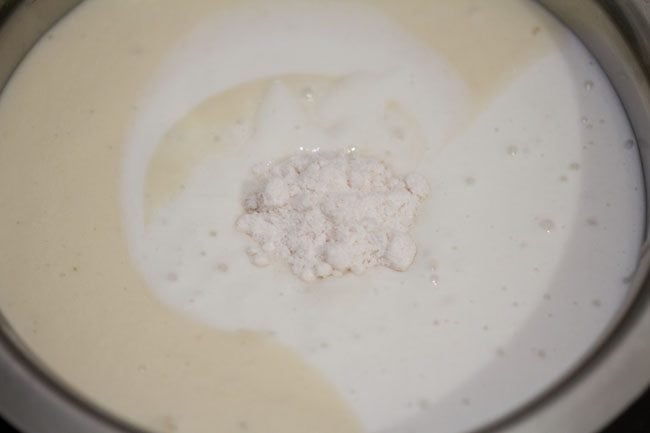
14. Mix the salt very well with the batter. Also mix both the batters very well. cover and keep aside to ferment for 8 to 9 hours. You can keep for less or more time and this will depend on the temperature conditions in your city.

15. The batter the next day. I kept it for about 13 hours and 35 minutes as it is cold during monsoons here.
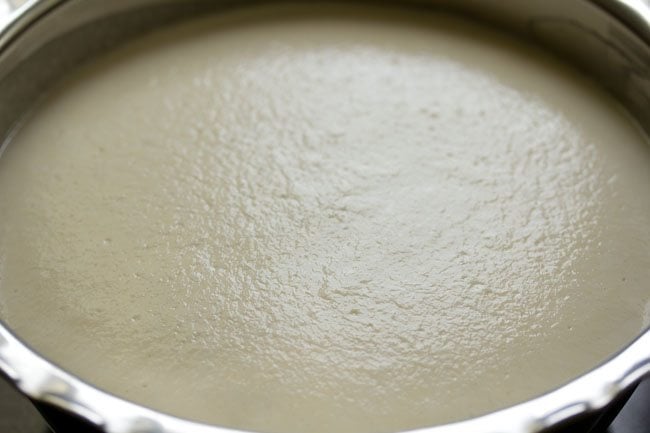
16. Now lightly stir the batter, before you begin to make dosa. you will also see tiny air pockets in the batter.

Cooking ghee roast dosa
17. Now heat a thick bottomed cast iron griddle or non stick pan. The pan should be medium hot. You can keep the heat to a low or medium while making dosas.
If using an iron pan, then spread ¼ to ½ teaspoon oil or ghee all over the pan. Use a silicon brush or spoon or kitchen towel or onion halve to spread the oil/ghee.
Do not spread oil/ghee on a non stick pan. Do keep the heat on low to low-medium flame, so that you are easily able to spread the batter. If the pan base is very thick, then keep the flame to medium. Pour a ladle of the batter in the center.
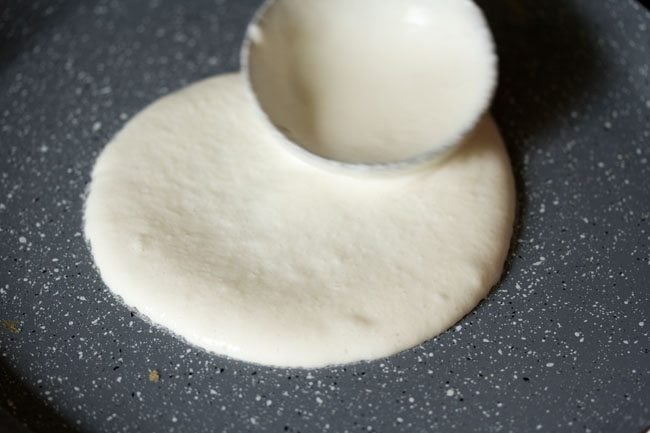
18. With the ladle gently spread the batter to get a neat round shape and a thin dosa. If the pan is very hot, you won’t be able to spread the batter in a round circle. So for a nonstick pan, just lift the pan from the flame and keep outside for some seconds or half a minute. Then again place it on the fire.
For a iron griddle, you can sprinkle some water on the pan. This reduces the temperature of the cast iron griddle. Please do not sprinkle water on non stick pan. The non stick coating can wear off.
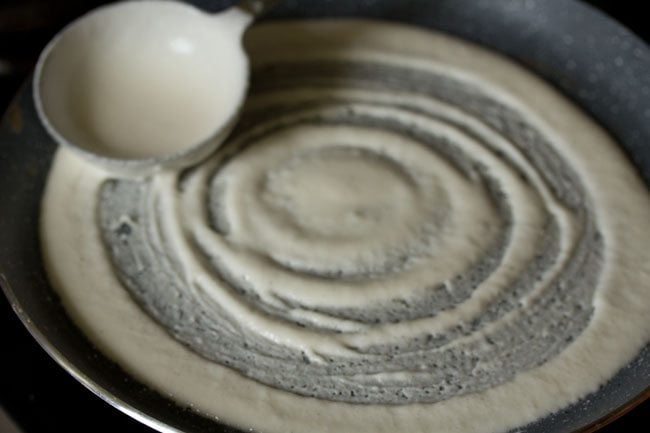
19. On a medium heat, cook the dosa.
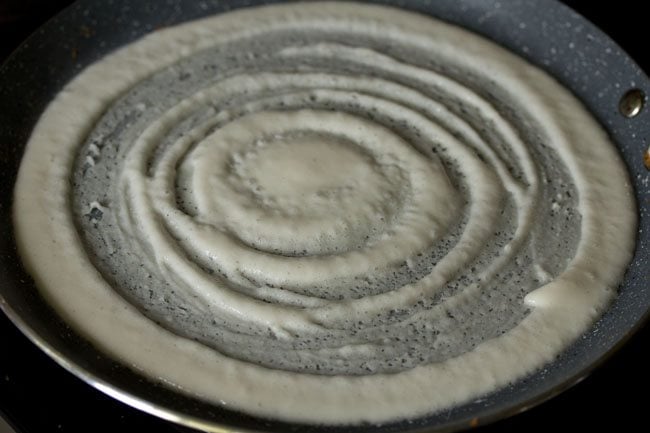
20. Let the top get cooked.
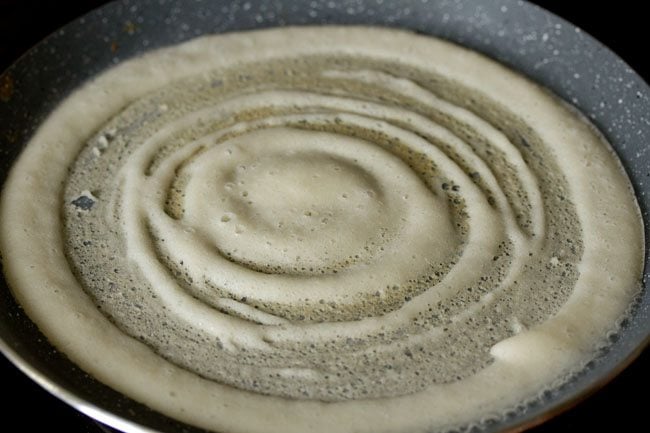
21. When the top looks cooked, sprinkle ½ to 1 teaspoon ghee at the sides and on the top of dosa. You can add less or more ghee as per your requirements.
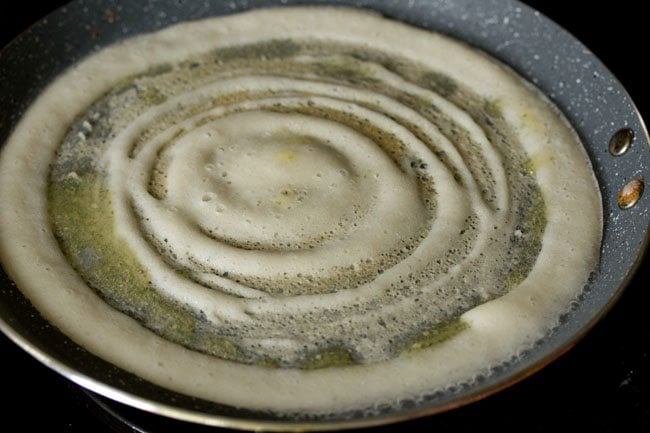
22. Now with the spoon spread the ghee all over.
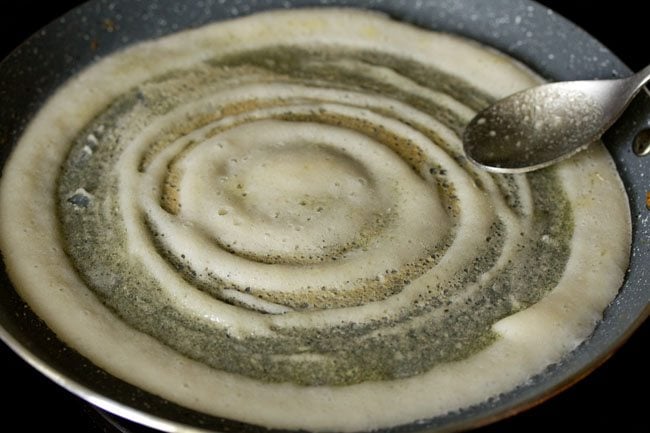
23. Keep cooking till you see the base becoming golden.

24. The more the base becomes golden, the dosa becomes more crisp.
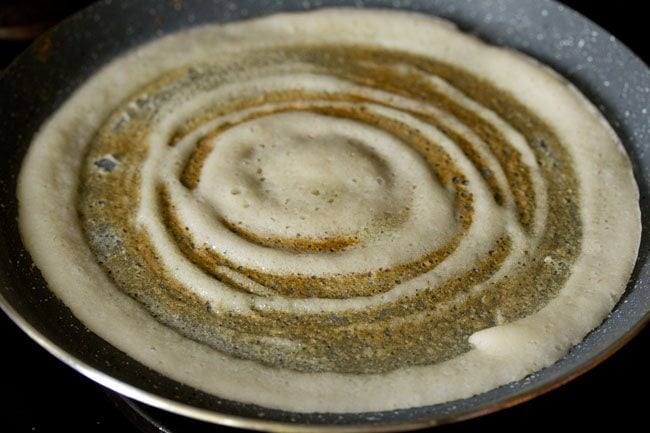
25. Here the ghee roast dosa is ready to be folded.
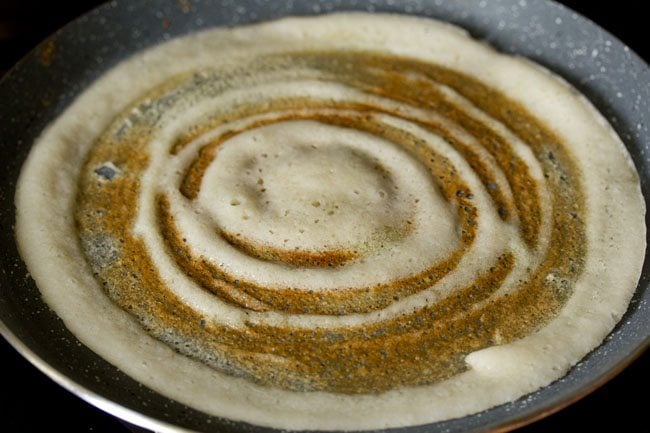
26. Fold and serve hot.
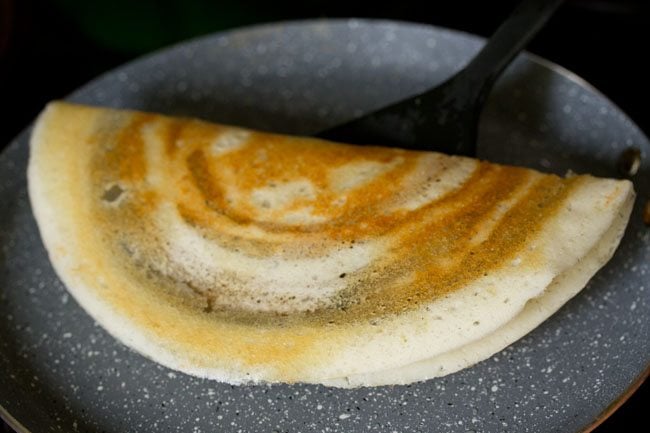
27. Crisp ghee roast dosa can be served hot with coconut chutney or a combination of coconut chutney and sambar.

More dosa varieties
Please be sure to rate the recipe in the recipe card or leave a comment below if you have made it. For more vegetarian inspirations, Sign Up for my emails or follow me on Instagram, Youtube, Facebook, Pinterest or Twitter.

Ghee Roast Dosa
Ingredients
- 1.5 cups idli rice or parboiled rice or 330 grams parboiled rice (ukda chawal or sela chawal)
- 125 grams urad dal or ½ cup urad dal (split and husked black gram)
- 1 tablespoon chana dal (split and husked bengal gram)
- 35 grams thick poha or ⅓ cup thick poha (flattened rice)
- 20 methi seeds (fenugreek seeds)
- 1 cup water for soaking urad dal
- 2 cups water for soaking rice
- ½ teaspoon rock salt (edible and food grade)
- 1 cup water for grinding rice. can also add ¾ cup water for grinding rice
- ½ cup water for grinding dal
- Ghee (clarified butter) as required
Instructions
soaking rice and lentils
- First take all the ingredients in bowls:
- –1.5 cups idli rice or parboiled rice in one bowl
- – 1/2 cup urad dal + 1 tablespoon chana dal + 20 methi seeds/fenugreek seeds in second bowl
- –1/3 cup thick poha in a third bowl.
- Rinse the lentils and methi seeds a couple of times. Then soak them in 1 cup water for 4 to 5 hours.
- Rinse the rice a couple of times and keep aside.
- Rinse poha once or twice and then add to the rice.
- Pour 2 cups water. Stir and soak both rice and poha together for 4 to 5 hours.
grinding dosa batter
- Before grinding, strain the water from the soaked lentils and keep it for grinding urad dal.
- Add the lentils in the grinder jar. Also add 1/2 cup of the soaked and strained water to the dal.
- Grind the urad dal, chana dal and methi seeds till you get a batter which is light and fluffy. The urad dal has to be ground really well, so that the batter ferments well.
- Remove the batter in a bowl or pan with a spatula.
- Strain the rice well. Then in the same grinder, add the soaked rice and 1 cup fresh water. You can grind rice in one batch or in two to three batches. This will depend on the size of the grinder jar. I ground in one batch and added 1 cup water for grinding. You can even add 3/4 cup water while grinding. Addition of water will depend on the quality of rice.
- Grind the rice till you get a fine grainy consistency in it. The rice batter should have a fine rawa like consistency.
- Now pour the batter in the same pan or bowl containing the urad dal batter.
- Add 1/2 teaspoon rock salt or add as per taste.
- Mix the salt very well with the batter. Also mix both the batters very well. Cover and keep aside to ferment for 8 to 9 hours. You can keep batter to ferment for less or more time and this will depend with the temperature conditions in your city.
- I kept for about 13 hours and 35 minutes as it is cold during monsoons here.
- Now lightly stir the batter, before you begin to make dosa. You will also see tiny air pockets in the batter.
making ghee roast dosa
- Now heat a thick bottomed cast iron griddle or non stick pan. The pan should be medium hot. You can keep the flame to a low or medium while making dosas. If using an iron pan, then spread ¼ to ½ tsp oil/ghee all over the pan. Use a silicon brush or spoon or kitchen towel or an onion halve to spread the oil/ghee. Do not spread oil/ghee on a non stick pan. Do keep the flame on low to low-medium flame, so that you are easily able to spread the batter. If the pan base is very thick, then keep the flame to medium. Pour a ladle of the batter in the center.
- With the ladle gently spread the batter to get a neat round shape and a thin dosa.
- If the pan is very hot, you won’t be able to spread the batter in a round circle. So for a nonstick pan, just lift the pan from the flame and keep outside for some seconds or half a minute. Then again place it on the fire. For a iron griddle, you can sprinkle some water on the pan. This reduces the temperature of the cast iron griddle. Please do not sprinkle water on non stick pan. The non stick coating can wear off.
- On a medium flame, cook the dosa.
- When the top looks cooked, sprinkle 1/2 to 1 teaspoon ghee at the sides and on the top of dosa. You can add less or more ghee as per your requirements.
- Now with the spoon spread the ghee all over.
- Keep cooking till you see the base becoming golden.
- The more the base becomes golden, the dosa becomes more crisp.
- Fold and serve ghee roast dosa hot.
- Ghee roast dosa can be served with coconut chutney or a combination of coconut chutney and sambar.
Notes
- Idli rice – idli rava.
- Chana dal – arhar dal (pigeon pea lentils).
- Ghee – butter or oil.
This Ghee Roast Dosa post from the blog archives first published in September 2016 has been updated and republished on December 2022.









Can I soak the lentils and rice/poha overnight? We are planning to make the dosa in the evening so I plan to allow the batter to ferment from morning till evening. Would like to soak everything the night before so I am not so rushed for time
don’t soak the lentils and rice/poha overnight. the batter might end up becoming too sour or bitter. this happens if the lentils are soaked for long time and then ground bater is again fermented. i would suggest to soak for 4 to 5 hours in the evening. then drain water well. keep the lentils, poha and rice in a bowl covered with a lid in the fridge. then in the morning grind the batter and then ferment. you can let the rice, poha and lentils come at room temperature or grind with warm water.
hi
Im in this issue too – let me know if ths will work.
soak the lentis for 4-5 hours. then in evening make the butter. them ferment over night, and in the morning put the the refigerator.
noam, you can do. once the batter ferments then you can keep it in the refrigerator.